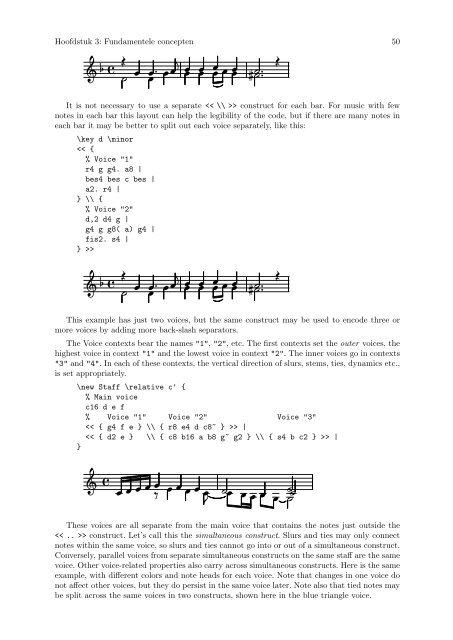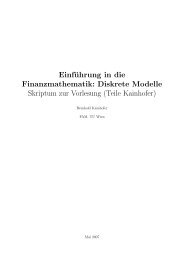LilyPond Beginnershandleiding
LilyPond Beginnershandleiding
LilyPond Beginnershandleiding
You also want an ePaper? Increase the reach of your titles
YUMPU automatically turns print PDFs into web optimized ePapers that Google loves.
Hoofdstuk 3: Fundamentele concepten 50<br />
<br />
<br />
<br />
<br />
<br />
<br />
It is not necessary to use a separate > construct for each bar. For music with few<br />
notes in each bar this layout can help the legibility of the code, but if there are many notes in<br />
each bar it may be better to split out each voice separately, like this:<br />
\key d \minor<br />
><br />
<br />
<br />
<br />
<br />
<br />
<br />
This example has just two voices, but the same construct may be used to encode three or<br />
more voices by adding more back-slash separators.<br />
The Voice contexts bear the names "1", "2", etc. The first contexts set the outer voices, the<br />
highest voice in context "1" and the lowest voice in context "2". The inner voices go in contexts<br />
"3" and "4". In each of these contexts, the vertical direction of slurs, stems, ties, dynamics etc.,<br />
is set appropriately.<br />
\new Staff \relative c' {<br />
% Main voice<br />
c16 d e f<br />
% Voice "1" Voice "2" Voice "3"<br />
> |<br />
> |<br />
}<br />
<br />
<br />
<br />
<br />
<br />
These voices are all separate from the main voice that contains the notes just outside the<br />
> construct. Let’s call this the simultaneous construct. Slurs and ties may only connect<br />
notes within the same voice, so slurs and ties cannot go into or out of a simultaneous construct.<br />
Conversely, parallel voices from separate simultaneous constructs on the same staff are the same<br />
voice. Other voice-related properties also carry across simultaneous constructs. Here is the same<br />
example, with different colors and note heads for each voice. Note that changes in one voice do<br />
not affect other voices, but they do persist in the same voice later. Note also that tied notes may<br />
be split across the same voices in two constructs, shown here in the blue triangle voice.



